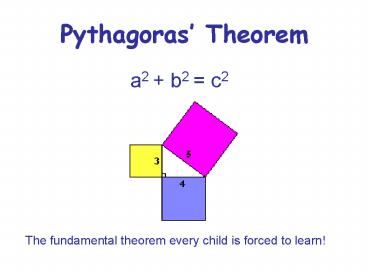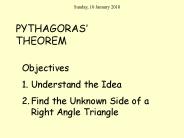Pythagoras Theorem
1 / 11
Title: Pythagoras Theorem
1
Pythagoras Theorem
a2 b2 c2
The fundamental theorem every child is forced to
learn!
2
History of the theorem
Pythagoras of Samos was a Greek philosopher
responsible for many important developments in
mathematics!
But rumour has it Pythagoras Theorem was known
to the Babylonians some 1000 years before
Pythagoras.
However we all believe he was the first person
to prove the theorem and that is why the theorem
takes his name.
3
Pythagoras in school
The National Curriculum Keystage 3 and Keystage
4 foundation Ma3 Shape, space and measures Pupils
should be taught to Understand, recall and use
Pythagoras theorem Keystage 4 higher Ma3 Shape,
space and measures Pupils should be taught
to Understand, recall and use Pythagoras
Theorem in 2-D, then 3-D problems investigate
the geometry of cuboids including cubes and
shapes made from cuboids, including the use of
Pythagoras theorem to calculate lengths in three
dimensions
4
Proofs!
Proof without words! If only all proofs were as
simple.
GUINNESS WORLD RECORD
Most Proofs Of Pythagoras' TheoremEleftherios
Argryopoulos of Greece, has discovered
520 different proofs of the Pythagorean theorem
over a period of 11 years from 1986 to 1997.
5
The theorem in 3-D
The application of Pythagoras Theorem in three
dimensions involves the relationship between
the perpendicular edges of a rectangular block
and the solid diagonal of the same block.
Usually denoted a2 b2 c2 d2, but here d2
h2 You just cant get the pictures these days!
6
Pythagorean Triples
There is a simple formula that gives all the
Pythagorean triples. Suppose m and n are two
positive integers with m lt n . Then the triple
can be found a n2 m2 , b 2mn , c n2
m2 This formula gives all the Pythagorean
triples! Here are the first few m 1, n 2
gives (3,4,5) m 1, n 3 gives
(8,6,10) m 2, n 3 gives (5,12,13) m 2,
n 4 gives (12,16,20) and so on m 6, n 10
gives (64,120,136)
7
More on triples!
Generating triples using Fibonacci numbers and
Lucas numbers
Fibonacci numbers 0,1,1,2,3,5,8,13,21, Fn1
Fn-1 Fn where F0 0, F1 1 Lucas numbers
2,1,3,4,7,11,18,29,47, Ln1 Ln-1 Ln where
L0 2, L1 1 Generating a triple Take 4
fibonacci numbers, say, 1,2,3,5 Fn , Fn1,
Fn2, Fn3 a 2 x (Fn1 x Fn2) 2 x (2x3)
12 b Fn x Fn3 1x5
5 c (Fn1) 2 (Fn2)2 2233
13 We have generated the Pythagorean triple
(12,5,13) This works exactly the same for 4
Lucas numbers!
8
Fibonacci numbers
9
Lucas Numbers
10
An advanced standpoint
Fermats Last Theorem xn yn zn has no
integer solutions for ngt2 Diophantine
Equations x2 y2 n x3 2y3 7z3 x2 2
y3 Finding Pythagorean quadruples! Generating
triples that are Fibonacci numbers Generating
triples that are Lucas numbers
11
Applications
- On a lighter note, does the theorem have any
applications??
Its main use is in architecture and any form of
structural planning By using Pythagoras theorem
to work out the hypotenuse of a drill you can
work out the size of the hole created! You can
use the theorem to work out the height of a house
or awkward object. Slightly more interesting a
musical harps strings are all angled. When
building a harp, if you take each string as a
hypotenuse you can work out the correct spacing
between each string using the theorem!































